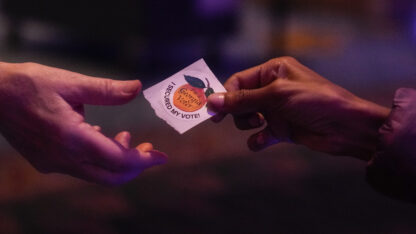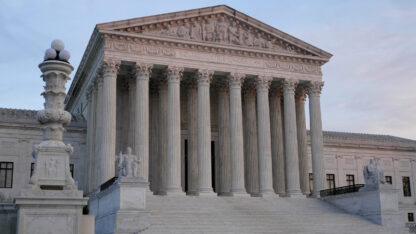In a major victory for Native American rights, the U.S. Supreme Court on Thursday upheld key provisions of the Indian Child Welfare Act, a law enacted 45 years ago to remedy decades of past government abuse.
By a 7-2 vote, the court ruled that the law does not impermissibly impose a federal mandate on traditionally state-regulated areas of power.
Writing for the court majority, Justice Amy Coney Barrett pointed to two centuries of precedent that have established a broad congressional right to legislate on Indian affairs, including family law matters.
“The Constitution does not erect a firewall around family law,” she said. “On the contrary,” she wrote, “we have not hesitated to find conflicting state family law pre-empted” by federal law.
While the tone of Barrett’s opinion was often technical, it is noteworthy that two of her seven children are adopted, as are Chief Justice John Robert’s children.
Background on the 1978 law
The Indian Child Welfare Act, known as ICWA, was enacted in 1978 after a congressional investigation found that in the 1950s, ’60s and ’70s over one-third of all Native children had been removed from their homes, some forcibly, and placed with non-Indian families and institutions with no ties to the tribes. To ensure that would never happen again, the law established three preferences for the placement of Native children when they are adopted or put in foster care: the first preference is for placement with the child’s extended family, then to other members of the tribe, and if neither of those is available, to members of another tribe.
Those preferences were challenged by the state of Texas and by non-Indian adoptive parents. They argued first that the law unconstitutionally supplanted the core functions states and their traditional role in family law matters, and second, that the adoption preferences were an unconstitutional racial classification.
But on Thursday the Supreme Court explicitly left the Indian Child Welfare law intact, prompting joy among Indian tribes.
The court’s decision, however, left one important question unresolved–whether the statute’s system of preferences for Native adoptive parents amounts to an unconstitutional racial preference. Several non-Indian adoptive parents made that argument, but the court said that for procedural reasons, they had no legal standing to bring their cases to the Supreme Court.
Justice Brett Kavanaugh joined the Barrett opinion, but wrote separately to say that in his view, the preference issue remains a “serious” one. Still, several Indian law experts said today that it may well be difficult to find a suitable test case to bring to the Supreme Court because most cases are settled without any appeal. Michigan State University law professor Kate Fort, who tracks these cases nationally, says that in the six years between 2015 and 2021, there were only 14 placement preference appeals in state courts.
“Given that we have hundreds of child protection cases every year, that’s a very small number,” she said.
Bertram Hirsch, who helped write the Indian Child Welfare Act back in the 1970s, adds that it is rare for an adoption case to last long enough to be a live dispute when it gets to the high court.
“It’s going to be extraordinarily difficult, I think, to find a plaintiff who is willing to not proceed to finalization of an adoption and instead keep a child and their family in limbo through years of litigation with no resolution,” he said.
Indeed, all three of the adoptions before the court today had been finalized, though one non-Indian couple, Chad and Jennifer Brackeen, is now trying to adopt a second Indian child. Matthew McGill, the lawyer who brought the ICWA challenge on their behalf, says he will pursue the race discrimination claim in state court adoption proceedings involving the second child, a 5-year-old girl who is the sister of the child the couple have already adopted.
Despite the win for the Indian Tribes on Thursday, Chief Hoskin is worried about other Indian preferences outside of adoptions: statutes that give special preferences for Indian gaming, Indian contracting and Indian employment at the Bureau of Indian Affairs.
“I’m always braced for the next challenge particularly on equal protection grounds because there’s a whole lot of statutes out there that are specific to bringing justice and fairness to Indian country,” he said.
Dissenting view
Dissenting from Thursday’s ruling were Justices Clarence Thomas and Samuel Alito, who wrote separate dissenting opinions. Thomas’ 40-page dissent argued his long-held view that the Constitution’s Indian protections do not extend beyond matters of trade and commerce. And Alito wrote that in his view Congress “does not have the power to sacrifice the best interests of vulnerable children to promote the interests of the tribes in maintaining membership.”
Justice Neil Gorsuch, who has earned a reputation as the most knowledgeable justice on questions of Indian history and the most aggressive defender of Indian rights, joined Justice Barrett’s majority decision in full but wrote what was essentially a rebuttal to the dissenters.
The mass removal of children from their family homes in the 1950s, ’60s and ’70s, he wrote, “was only the latest iteration of a much older policy of removing Indian children from their families–one intentionally spearheaded by federal officials with the aid of their state counterparts nearly 150 years ago. In all its many forms, the dissolution of the Indian family has had devastating effects on children and parents alike. It has also presented an existential threat to the continued vitality of the tribes–something many federal and state officials over the years saw as a feature, not a flaw.”
“In adopting the Indian Child Welfare Act,” he concluded, Congress exercised its lawful authority “to secure the right of Indian parents to raise their families as they please; the right of Indian children to grow in their culture; and the right of Indian communities to resist fading into the twilight of history.”








